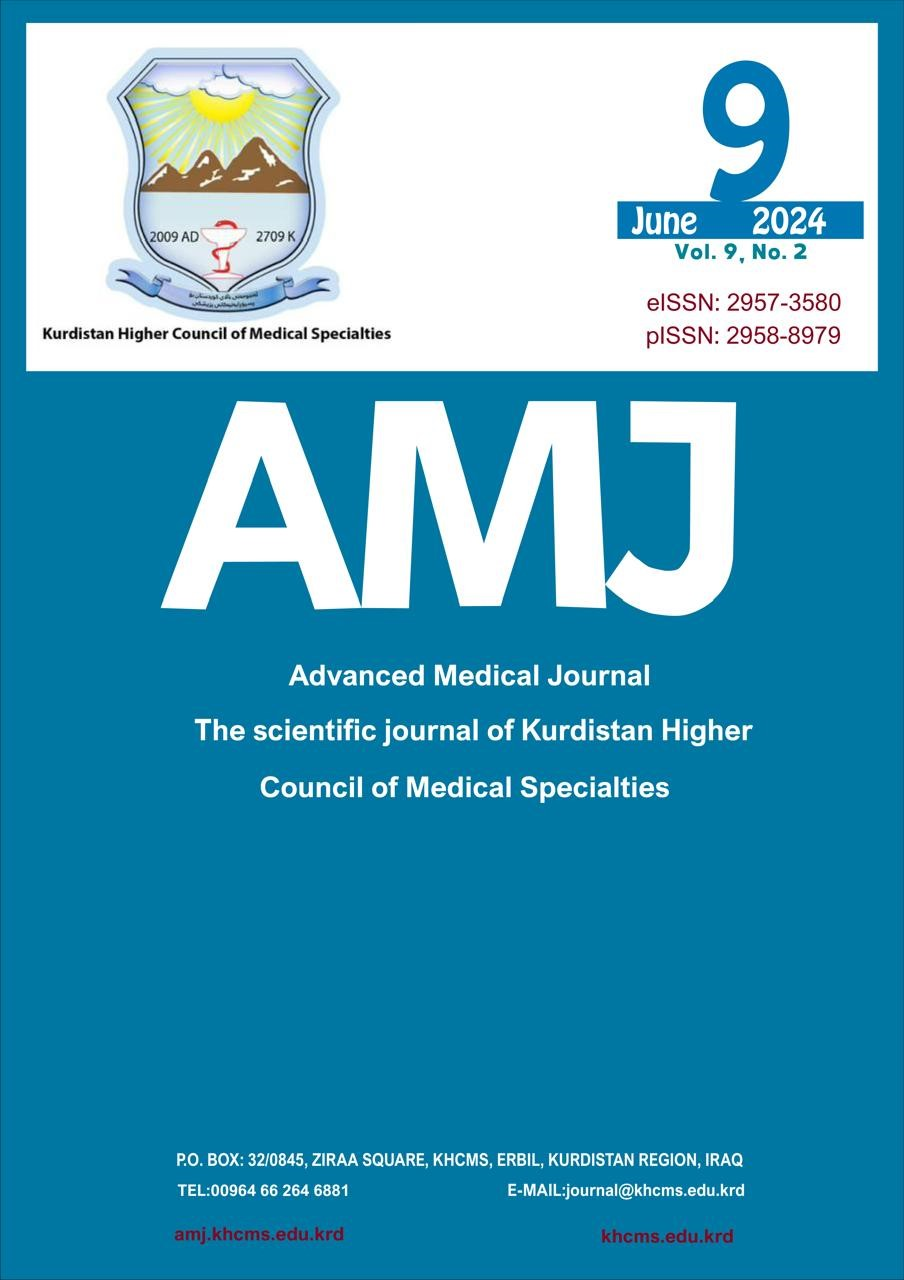Mortality rates among vaccinated and unvaccinated covid19 patients in Duhok hospitals, Kurdistan Region, Iraq
DOI:
https://doi.org/10.56056/amj.2024.259Keywords:
Coronavirus, Covid-19 vaccine, Covid severity, Mortality rateAbstract
Background and objectives: The corona virusvaccines are important in controlling the pandemic. In Kurdistan Region of Iraq three types of vaccines are available; Pfizer, AstraZeneca and SinoPharm. The objectiveof the study was to determine the effect of vaccine on severity and mortality rate among Covid-19 cases in Duhok, Iraq.
Methods: In this Prospective study, 470 of hospitalized covid19 cases in Duhok, Iraqi Kurdistan between 1st june 2021 to 1st june 2022 were enrolled. Demographic parameters including age, sex, and past medical history of chronic diseases were taken. The severity of cases was assessed based on respiratory rate, oxygen saturation, and percentage of chest involvement by CT scan. The types and doses of vaccines received by patients were recorded. The patients were followed-up by the outcome (recovered and discharged from the hospital or dead).
Results: The mean age of the patients was 64.98 years. The males were (51.49%, n=242) and females (48.51%, n=228). The majority of them did not receive any type of vaccines (81.49%, n=383). Most of the vaccinated patients received Pfizer vaccine. In term of Covid-19 severity, the study showed (65.75%, n=309) had mild-moderate disease and (34.26, n= 161) had severe disease. Moreover, the mortality rate was lower among vaccinated patients compared with unvaccinated patients 24.14% to 40.73% respectively. The study revealed that having the severe cases and being old were considered the main independent predictor of mortality among the patients (p value <0.0001).
Conclusions: Vaccinated patients had lower chance of severe chest involvement, oxygen requirement and death rate compared to unvaccinated patients in our study.
Downloads
References
Patel R, Kaki M, Potluri VS, Kahar P, Khanna D. A comprehensive review of SARS-CoV-2 vaccines: Pfizer, Moderna & Johnson & Johnson. Hum Vaccine Immunotherapy 2022;18(1):7.
Malik JA, Ahmed S, Mir A, et al. The SARS-CoV-2 mutations versus vaccine effectiveness: New opportunities to new challenges. J Infect Public Health 2022;15(2):228-40.
Adhikari SP, Meng S, Wu YJ, et al. Epidemiology, causes, clinical manifestation and diagnosis, prevention and control of coronavirus disease (COVID-19) during the early outbreak period: a scoping review. Infect Dis Poverty 2020;9(1):020-00646.
Salian VS, Wright JA, Vedell PT, et al. COVID-19 Transmission, Current Treatment, and Future Therapeutic Strategies. Mol. Pharm.2021;18(3):754-71.
Wang D, Hu B, Hu C,et al. Clinical Characteristics of 138 Hospitalized Patients With 2019 Novel Coronavirus–Infected Pneumonia in Wuhan, China. JAMA 2020;323(11):1061-9.
Lippi G, Plebani M. The critical role of laboratory medicine during coronavirus disease 2019 (COVID-19) and other viral outbreaks. Clin Chem Lab Med 2020;58(7):1063-9.
Ciotti M, Ciccozzi M, Terrinoni A, Jiang WC, Wang CB, Bernardini S. The COVID-19 pandemic. Crit Rev Clin Lab Sci 2020;57(6):365-88.
Ruan Q, Yang K, Wang W, Jiang L, Song J. Clinical predictors of mortality due to COVID-19 based on an analysis of data of 150 patients from Wuhan, China: Intensive Care Med. 2020;46(5):846-8. doi: 10.1007/s00134-020-05991-x.
Felsenstein S, Herbert JA, McNamara PS, Hedrich CM. COVID-19: Immunology and treatment options. Clin Immunol. 2020 issue;215:108448.
Chaudhary FA, Ahmad B, Khalid MD, Fazal A, Javaid MM, Butt DQ. Factors influencing COVID-19 vaccine hesitancy and acceptance among the Pakistani population. Hum Vaccin Immunother 2021;17(10):3365-70.
Albatineh AN, Dalvand P, Aslani M, et al. Prevalence and factors associated with COVID-19 vaccine acceptance among the general population in Asadabad, Iran: a cross-sectional study. Trop Med Health. 2022;50(1):59.
Mosa AA. The potential non-reporting of Covid-19 cases at the Zakho Medical College in Kurdistan Region: a student perspective. Int J Surg. 2022;7(3).
Alkandari D, Herbert JA, Alkhalaf MA, Yates C, Panagiotou S. SARS-CoV-2 vaccines: fast track versus efficacy. Lancet Microbe 2021;2(3):e89-e90.
Kaur SP, Gupta V. COVID-19 Vaccine: A comprehensive status report. Virus Res
.2020;issue 288:198114.
Abdulah DM, Mirza AMS. Receiving COVID-19 vaccine, hospitalization, and outcomes of patients with COVID-19: A prospective study. Monaldi Arch Chest Dis 2022;24(10).
Thomas SJ, Moreira ED, Kitchin N, et al. Safety and Efficacy of the BNT162b2 mRNA Covid-19 Vaccine through 6 Months. N Engl J Med 2021;385(19):1761-73.
Voysey M, Clemens SAC, Madhi SA, et al. Safety and efficacy of the ChAdOx1 nCoV-19 vaccine (AZD1222) against SARS-CoV-2: an interim analysis of four randomised controlled trials in Brazil, South Africa, and the UK. Lancet 2021; 397(10269):99-111.
Mohammad AM, Sgery ASH, Hussein NR. A rare case of absolute thrombocytopaenia in a COVID-19 patient: Case report: Ann Med Surg (Lond). 2021; 72:103097. doi: 10.1016/j.amsu.2021.103097. Epub 2021 Nov 22.
Muthukrishnan J, Vardhan V, Mangalesh S, et al. Vaccination status and COVID-19 related mortality: A hospital based cross sectional study. Med J Armed Forces India 2021;77(2):S278-S82.
Demir ?, YILMAZ RS, Betül K, Özkaraka? H, ÇALIK ?. Relationships between vaccination, age, and mortality in the COVID-19 intensive care patients. Eur. J. Res. 2022;8(6):783-9.
Uzun O, Akpolat T, Varol A, et al. COVID-19: vaccination vs. hospitalization. Infection Nation.Lib.Med. 2022;50(3):747-52.
Mohammed I, Nauman A, et al.The efficacy and effectiveness of the COVID-19 vaccines in reducing infection, severity, hospitalization, and mortality: a systematic review. Hum Vaccin Immunother 2022;18(1):3.
Geng J, Yu X, Bao H, et al. Chronic Diseases as a Predictor for Severity and Mortality of COVID-19: A Systematic Review with Cumulative Meta-Analysis: Front Med (Lausanne). 2021;issue8:588013. doi: 10.3389/fmed.2021.588013. eCollection 2021.
Mohammad AM. The pandemic of coronavirus: misconceptions from the land of Mesopotamia. Int J Surg. 2021;4(3):e52.
Downloads
Published
How to Cite
Issue
Section
License
Copyright (c) 2024 Wahab Farho Tahlo, Ameen Mosa Mohammad

This work is licensed under a Creative Commons Attribution-NonCommercial-ShareAlike 4.0 International License.
The copyright on any article published in AMJ (The Scientific Journal of Kurdistan Higher Council of Medical Specialties )is retained by the author(s) in agreement with the Creative Commons Attribution Non-Commercial ShareAlike License (CC BY-NC-SA 4.0)







